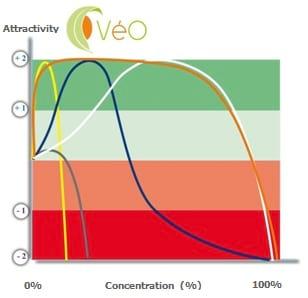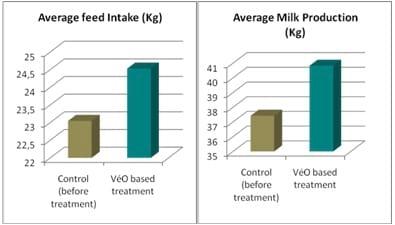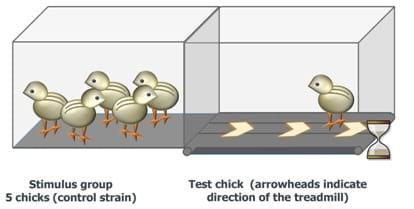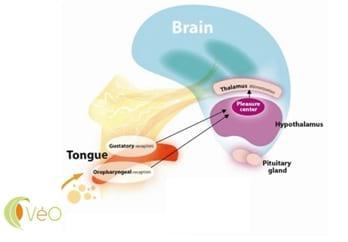Feed loyalty through olfatory experience
Published: September 23, 2009
By: Phodé S.A.
If we often hear that in the modern Man, olfaction, our most primal sense, has also became our worse sense, it is highly developed in most animals, and often an essential part of their survival. The sense of smell warns them of danger, help them to find food and discriminate toxic from nutritious plants for example. Olfaction is also involved in reproduction, from matting to the recognition of one's own offspring. Cattle and, to a higher degree, swine have a very sharp sense of smell, as illustrated by the truffle-hunting sows. More surprisingly, aquatic species are also very good "smellers", and insects can smell too. Birds were traditionally thought to have a very poor sense of smell, but in 2004, the chicken genome sequence revealed a number of olfactive receptor genes comparable to human (1)!
The olfactory bulb, which is the part of the nervous system responsible for olfactive perception, is closely related to the amygdala, which processes emotion, and is part of the limbic system: the sense of smell is intricately linked to the "emotional brain" and odours are able to influence well-being and certain behaviour (see Fig. 5). While certain odours can have a positive effect on mood, behaviour and appetite, negative odours can represent a source of stress.
The olfactory bulb is also linked to the hippocampus, responsible for associative learning, and we all have experienced the power of olfactive memory. Experts state that the formation of olfactive memory is unconscious and starts even before birth. In animals, this is well illustrated by the salmons' ability to find their way and recognize their original river after several seasons spent in the sea, guided by its olfactive memory (2).
The idea behind sensory stimulation and sensory feed additives is to take advantage of the important role of olfaction and olfactive memory to stimulate appetite and generate feed loyalty in animals. Not only this, but to improve well-being and reduce the impact of stress by creating a positive sensory experience. It took twelve years to French experts in both olfaction and nutrition from laboratoires Phodé, to develop and validate at field level such a sensory complex, called VéO®. VéO® is at the core of Phodé's range of sensory feed additives adapted to the specific needs of each animal species and physiological stage.
Born from a collection of odors... and 10,000 chicks
The center of olfactive perception in the brain is relatively well conserved among species. Birds chicks have thus been used as a model to evaluate olfactive responses by animals to various compounds, according to the method described by Porter et al. in 1999 (3). These authors have shown that chicks that are induced to sleep in the hand respond to olfactory stimuli in predictable ways (head shakes, beak claps and peeping) that were not observed in awake chicks, allowing to assess the impact of odorant compounds.
In this simple and non invasive methodology, one-day old chicks, deprived from water and feed since birth, held in the hand under a heatlamp, become inactive and close their eyes within 2 minutes. Sleeping chicks are exposed to one odorant stimuli and a negative control (soya oil). The compound is rated according to the chick behaviour (table 1).
Score | Observation | Result |
0 | No reaction | Neutral |
1 | One or more beak claps | Positively perceived |
2 | Head shake, silent waking | Negatively perceived |
3 | Sudden waking, peeping | Very negatively perceived |
Table 1: Assessment of odour perception in one-day old sleeping chicks (from Porter et al., 1999).
In our experimental plan, a total of 600 molecules and botanicals were screened, issued from the collection of aromatic compounds authorized in Europe as feed additives. After a first selection of individual ingredients, several associations were formulated and tested at different concentrations. Over 10 000 chicks were involved in the study: chickens, quails and pheasants.
For each series of 20 chicks, two compounds were tested against the control. The same chicks were used only once.
Finally, the complex which elicited the optimal response in terms of concentration and attractivity was selected: a positive response with the lowest concentration (Figure 1).
Once formulated, this sensory complex, named VéO®, was tested in various conditions and in other animal species to evaluate its effects on attractivity, appetite, feed loyalty and behaviour.

Figure 1: Dose response curves for different aromatic compounds (in Orange, VéO®; Porter method)
Enhanced feed intake
VéO® effects on feed intake have been illustrated by various field trials with different animal species.
In dairy cows, several trials with various feed additives containing VéO® have shown a positive effect on feed consumption, giving rise to increased milk production (Figure 2).

Figure 2: Example of VéO® trial in dairy cows: mean values for 5 herds, 4,000 dairy cows in total treated for 7 days with Cristalfeed® (a feed additive containing VéO®) (USA, 2002).
A trial in sows in peri-partum showed the attractive effect of VéO® at time of high stress and metabolic pressure for the sow, when it is crucial to optimise feed intake (farrowing and onset of lactation). This trial took place in an independent research centre in Canada, between February and May 2007, involving 40 pregnant sows in total, split up into two groups, equivalent in terms of parity and lactation duration. The sows received the treatment from five days prior to farrowing until weaning. All the sows received the same lactation diet containing corn, soya meal, micronized soya beans, soya husks and a minerals and vitamins premix. In addition, sows in the treated group received Phoderush®, an energizing and physiological enhancer containing VéO® as well as a natural energy supply and selected vegetal extracts (antioxidant properties). This trial showed an increase in sow daily feed intake in peri-partum. The additive also improved litter performance at weaning (Figure 3).

Figure 3: Effect of VéO® on sows feed consumption in early lactation (+5%).
Improved response to stress
In animal trials with additives based on VéO®, a positive impact on animal response to stress in production conditions was reported on various occasions. But one particular experiment was conducted at INRA (1999, unpublished results) to assess the effect of VéO® on animal behaviour. This experimental model involved young Japanese quails (Coturnix coturnix japonica), aged 6-8 days. Three strains of birds were used, characterised by their level of social motivation (their tendency to rejoin and stay close to peers) (4): the high social motivated (S+), the low social motivated (S-), and neutral (ST). For each type, two groups of 30 birds (control and VéO®) were individually tested for their reaction towards a group of peers using a treadmill device (5): the amount of time the tested subject spends away from a "stimulus" group of conspecifics is recorded. For the control group, each bird was tested separately without odorisation. In the VéO® group, the air surrounding the bird was odorized with VéO® (continuous release by spraying).

Figure 4: The treadmill test: a social behaviour experimental model in quail (INRA, France, from Mills and Faure, 1990).
For the three types of quails, VéO® had a positive effect on social motivation: the quails rejoined the stimulus group earlier than in the absence of odorisation (figure 5). Social motivation is negatively correlated with excitability. A decrease in excitability is synonymous with an adaptation to stress. Thus, it appears that VéO® reduced the stress of the young quails when the animal is alone.

Figure 5: Effect of VéO® on quail social motivation.
In another experiment, broiler chicken eggs were odorised with VéO® three days prior to hatching and the chicks feed intake was measured for ten days. It appeared that feed intake in the first day of life as well as total feed intake for the first 10 days was improved for the chicks subject to VéO® odorisation as compared to control eggs (P< 0.05), while feed composition was unchanged(no VéO®): this showed that VéO® exerts a positive olfactory stimulation on the animals and reduces stress of newly hatched chicks.
Conclusion: a dual action at brain-level
The two types of effects that VéO® exerts in animals are linked to distinct modes of action in the brain.
Firstly, VéO® creates a positive and unique sensory experience that will imprint onto the animal's deep memory. This mechanism induces feed loyalty (Figure 6).

Figure 6: How the action of VéO® on the cerebral system enhances feed loyalty
Secondly, the observed effects of VéO® on appetite and stress are near of those relating to endogenous cannabinoids, the molecules which modulate the transmission of nervous messages at the level of the synapse, the link between two neurons. This hypothesis of action mode is currently under validation.
Pleasure, attractivity, appetite stimulation, and stress reduction: these combined effects are able to enhance animal's feed intake and well-being in a natural way.
Ref:
- International Chicken Genome Sequencing Consortium (2004). Sequence and comparative analysis of the chicken genome provide unique perspectives on vertebrate evolution. Nature, 432(7018):695-716.
- Hasler, A.D., and Scholz, A.T. (1983). Olfactory imprinting and homing in salmon. Springer-Verlag, Berlin, 134
- Porter, R. H., Hepper, P. G., Bouchot, C. and Picard, M. (1999). A simple method for testing odor detection and discrimination in chicks. Physiol. Behav. 67,459 -462
- Mills, A.D., & Faure, J.M. (1991). Divergent selection for duration of tonic immobility and social reinstatement behavior in Japanese quail (Costurnix costurnix japonica) chicks. Journal of Comparative Psychology. 105 (1), 25-38.
- Mills, A.D., & Faure, J.M. (1990). The treadmill test for the measurement of social motivation in Phasianadae chicks. Medical Science Research, 18, 179-180.
Related topics:
Recommend
Comment
Share
Recommend
Reply
Phode
15 de diciembre de 2009
Dear Sirs,
Thanks a lot for your comments and interest.
Indeed, our product are sold in Netherlands through a distibutor.
For more information, you could contact our Responsible Person.
Recommend
Reply
13 de noviembre de 2009
Interesting research as authors explored new approach to enhance productivity. It certainly require some independent references.
Recommend
Reply
Tesgo International BV
12 de noviembre de 2009
Dear Sirs,
interesting to learn from your experience.
are your specialties selling in netherlands?
Tony Go, consultant
Recommend
Reply

Would you like to discuss another topic? Create a new post to engage with experts in the community.










.jpg&w=3840&q=75)